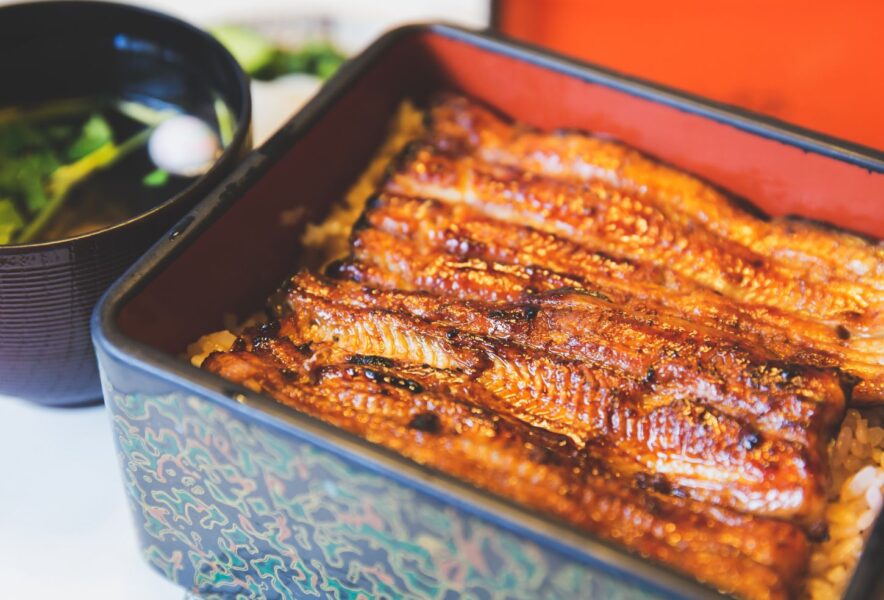What is Unagi? Japan’s Grilled Eel Delicacy
Unagi is a beloved Japanese dish featuring eel, traditionally grilled over a charcoal flame and glazed with a sweet soy-based sauce. The result is a perfectly tender, flavorful, and aromatic meal served with rice, often in a lacquered box called unajū or donburi. Unagi is more than just a meal in Japan; it’s a seasonal specialty, particularly popular during the summer when it’s believed to boost stamina and combat heat fatigue. On Doyo no Ushi no Hi (the midsummer day of the ox), many people eat unagi to gain strength during the hottest days of the year.
The History of Unagi in Japanese Cuisine
Unagi has been a staple of Japanese cuisine for centuries, with its popularity surging during the Edo period (1603–1868). Originally considered a working-class dish, unagi became a popular meal among the general public as demand for this nutritious and flavorful fish grew. The practice of grilling eel with tare, a thickened soy sauce with sugar and mirin, emerged in Edo (modern-day Tokyo) and spread throughout Japan. Over time, unagi has come to symbolize high-quality dining, often associated with special occasions and fine dining experiences.
How Unagi is Prepared: From Filleting to Grilling
The preparation of unagi is an art form in Japan. Skilled chefs meticulously fillet the eel and carefully place it on skewers. In the Kanto region (which includes Tokyo), the eel is first steamed before being grilled. This method results in a softer, more tender texture. In contrast, the Kansai region skips the steaming step, grilling the eel directly over the charcoal, giving it a crispier texture. The flavor is then enhanced with a rich tare glaze, applied in layers as the eel grills to achieve the perfect balance of savory and sweet.
Health Benefits of Unagi: More Than Just a Delicious Dish
Unagi is not only delicious but also packed with nutrients. It’s rich in vitamins such as A, B1, B2, and D, and it’s an excellent source of omega-3 fatty acids, which are beneficial for heart health. The protein-packed eel is also known for providing long-lasting energy, making it a go-to meal for those seeking to recharge during the hot and exhausting summer months.
Best Unagi Restaurants in Tokyo: Including Nodaiwa and Isegen
- Nodaiwa (Azabu)
Visit their website
Nodaiwa is one of Tokyo’s most famous unagi restaurants, having been in business for over 200 years. The restaurant is renowned for using only the freshest eel, prepared with the traditional Kanto-style technique, which includes steaming before grilling. The result is a light, fluffy texture that melts in your mouth. Nodaiwa is particularly known for its elegant, peaceful atmosphere, perfect for savoring unagi in its most refined form. - Isegen (Kanda)
Visit their website
Established in 1830, Isegen is a restaurant steeped in history. Although it originally specialized in fish hotpot (particularly cod dishes), Isegen has since expanded its offerings to include unagi. The restaurant serves traditional unagi dishes prepared with the utmost care, featuring succulent eel grilled to perfection. Its historic setting, complete with traditional tatami rooms, enhances the dining experience, offering a glimpse into Japan’s culinary heritage. - Hitsumabushi Nagoya Bincho (Shibuya)
Visit their website
For a unique twist on unagi, try hitsumabushi, a specialty from Nagoya where grilled eel is served atop rice with various seasonings. At Hitsumabushi Nagoya Bincho in Shibuya, you can enjoy unagi in three different ways: on its own, mixed with condiments like wasabi and green onion, or served as ochazuke (with tea poured over the rice). This provides a dynamic and flavorful dining experience. - Kanda Kikukawa (Kanda)
Visit their website
A Tokyo classic, Kanda Kikukawa has been serving unagi since 1927. The restaurant’s traditional preparation methods ensure that every bite is tender and full of rich, smoky flavor. Whether you’re a first-time visitor or a seasoned unagi lover, Kanda Kikukawa offers a truly memorable dining experience in a serene, old-world setting.

Comment